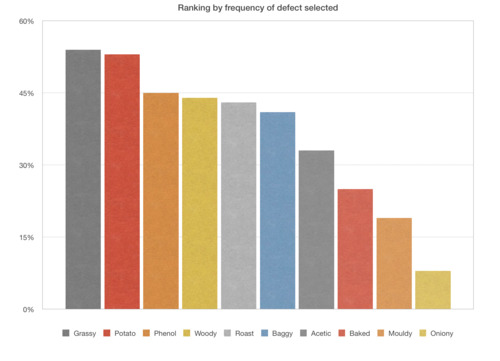#koreanabrista
Text
Coffee defect survey results.
I had overwhelming responses to the survey that I carried out couple of weeks ago, thank you everyone who took part!
The fundamental reason why I carried out the survey is because all too often I find that when I taste coffee either at production cupping at work, or just tasting coffee at a cafe, or anywhere around the world, there are differences in opinion about what we taste. I know this is inevitable, no matter how calibrated you are, there isn’t a default palate. But I’m not talking about the positive attributes about coffee, but more on the negatives of the coffee, the defects.
As a production roaster and cup taster, no matter where you are around the world you cup to identify the negative traits in coffee, and try to work out how to iron those negativity down in the cup. What I noticed though, was that after travelling around and cupping with a lot of different people, each individual people had certain defects they were way more sensitive to, and the other way round.
For defects such as potato, it’s quite an obvious defect as it stinks out the whole room, and actually tastes like potato skin in the cup. But there are some defects where you need training, and needs to be exposed to the defect frequently in order for you to pick it up in cupping. From the responses of the survey, which you will see down the bottom, large amount of people have said they can pick phenol up in the cup, but when you actually spike coffees with phenols in them, people find it hard to pick it up unless you tell them that there is phenol in them. I found this fascinating, and wanted to identify which defects were hot and which were not.

As you can see, you can group the result as 3 separate groups.
Firstly, 54% and 53% of people who took part in the survey selected grassy and potato defect, making these two the most recognisable defect amongst the 10 defects.
Second grouping you can see are 4 defects; phenol, woody, roast and baggy had very close results, as on average 42% of people selected these 4 defects, acetic came in close with 33% of people have said they can identify acetic defect.
Lastly, baked, mouldy and oniony were the defects which had the lowest selection, with oniony only being 8%.
Interestingly, out of all the people who took part, only 3% of people have said they can identify all the defects.
Before the survey results I initially thought potato defect would be over 90%, and defects such as acetic and baggy and grassy would be over 70%, but this is coming from my personal taste, and I find I’m very sensitive to defects such as acetic, baggy and grassy. In my opinion, baked is a strange one, as from my experience, it seems everyone has a very different idea of what baked is, so its a difficult one to agree with everyone what slightly baked coffee tastes like.
With the survey result, it leaves me with one question. Do we have enough tools to calibrate people with identifying defects in coffee? We can argue that potato is easy, but you only get it in Rwandan or Burundi coffees, and they are not around all year. Roast defects are easier to get, but defects such as phenol, mouldy and oniony are not that frequent. If we are to build our sensitivity, we need more exposure, but so far, I believe defects training are quite hard to do, but I believe we can work our way round this with a project I'm involved in which hopefully, will better our defects training.
Watch this space soon.
Mean while, please take part in another survey for me, and I promise you another blog post.
http://goo.gl/forms/3EYcqfKUir
3 notes
·
View notes